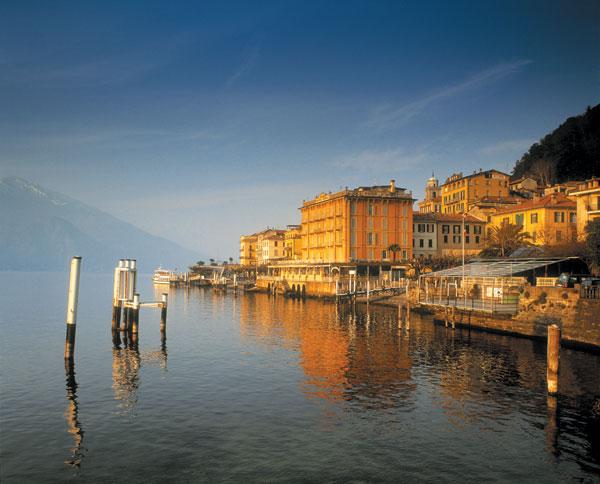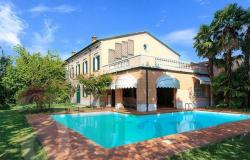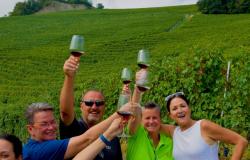Standing on the shoreline of Lake Como as the dusk sky illuminates the still waters, a faint mist rolling down from the surrounding hills and mountains that encircle it, you could be forgiven for thinking that Italy doesn’t get much better than this. And as it becomes half-light and the distant illuminations on the other side of the lake gather strength and laughing voices in a returning boat mingle with the shouts of busy waiters in a beckoning restaurant nearby, you might decide that many people are right, Lake Como is the most beautiful place in Italy. As always, such extravagant claims only have any truth in the quieter months of the year when the atmosphere around the lake has a wistful and romantic quality, unlike the place in summer when many would find the ugly face of mass tourism too much to bear.
Indeed the Italian Lakes, and Lombardy’s Lago di Como in particular, have been highly regarded since Roman times and this area is full of cultural associations as well as being the haunt of visiting aristocrats. Wordsworth waxed lyrical about this ‘treasure’ and it is still little changed from its heyday in the 19th century when it was an extremely fashionable destination. The moderate climate that allows vines, olives and lemons to flou-rish in sight of snow-capped peaks, the combination of clear, deep water and high mountains and the close proximity to Milan, Bergamo and a number of other cities has proved an irresistible cocktail of all that’s good about Italy to many visitors.
A fifty kilometre long inverted ‘Y’ shape reaches close to the Swiss border at its northern end and at the south-western tip lies Como, the elegant city that gave its name to the lake. At the end of the south-eastern leg sits the busy commercial centre of Lecco. The lake gets more peaceful as you head north from here and at the middle of the upturned ‘Y’ are Bellagio, Menaggio and Varenna, occupying three equally beautiful sites.
Como
Como itself has commercial, even industrialised, surroundings and is famous for its silk and textile industries, supplying Milan’s fashion trade with many of its materials. However, the old city centre is well worth visiting, in particular for its wonderful 14th-century Gothic-Renaissance cathedral in Piazza Cavour. Here, after a stiff espresso in one of the outdoor cafes, you can launch off to admire the 15th- century reliefs and fine Gothic rose window on the facade of the duomo and the main west doorway flanked by Renaissance statues of Pliny the Elder and Younger, both born in the city. Next door is the Broletto, the elegant Gothic former communal palace. Another interesting place to visit is the lakeside Tempio Voltiano devoted to the achievements of the 18th-century physicist Alessandro Volta who was responsible for the volt measurement as well as inventing the battery. For a fine view over this area, take the funicular up to the hill above Como.
Lecco’s Favourite Son
From Como you can explore the lake by taking one of the relatively fast boats that travel its full length, stopping off to visit some of the most popular places. The other southern lakeside city, Lecco, is a busy and industrialised place associated with one thing in particular in the minds of most Italians. This was the setting for I Promessi Sposi, (The Betrothed), probably the most famous of all Italian novels, written in the early 19th century by Lecco’s most renowned son, Alessandro Manzoni. A monument to him presides over the northern approach to the town and the Villa Manzoni on Via Amendola is now a museum dedicated to the author with his study furnished just as he left it. Otherwise this is not the sort of town most would visit on holiday, except to take advantage of its good transport links. Apart from excellent bus and train services, there is a cable car to the Piani d’Erna from where you can hike off into the mountains.
To many it is the central area of the lake that is most enchanting and full of romance. North of Como there is the small island, Isola Comacina, famous for its folklore and music festival during the Feast of San Giovanni Battista in the last week of June. From here one can take a boat to the Villa Balbianello, located on a spur on the west bank but not accessible from that side. This is one of the finest villas of the Italian Lakes and with its near neighbour, Villa Carlotta (see article in the garden section of this issue), it is one of the high points of the regular garden tours that are made around the lake. Close to the Comacina landing stage is the Locanda dell’Isola Comacina (tel +39 0344 55083) which has been run by the Pricilla family for nearly 40 years and offers excellent food, with beautiful views and entertaining hospitality.
Six kilometres north of Como is the quiet lakeside town of Torno occupying a superb position with excellent views of the southwestern leg of the lake. It has a charming little harbour offering several places to eat and hotel accommodation including the Albergo Ristorante Vapore located right on the waterside (tel +39 031 419311).
The Charms of Bellagio
To savour the charms of the central Lake Como area you just have to visit genteel Bellagio (yet another town dubbed the most beautiful in all of Italy) which has long been a magnet for writers, composers and artists and it is not hard to imagine why. Franz Liszt said of Bellagio ‘I know of no other spot more obviously blessed by heaven.’ Seeming to be always bathed in the warm reflected light of the lake, ringed by cypresses framing its oleanders and limes and its buildings painted in warm hues of ochre and cream, it does its best to maintain its atmospheric charm. The benign climate allows wine to be produced and a wide range of both Alpine and Mediterranean flowers flourish here. Stendhal was a frequent visitor and you can get a feel for the sophisticated and aristocratic lifestyle that was associated with the place by visiting the beautiful terraced gardens of the Villa Serbelloni, once the haunt of Russian princes and European monarchs and aristocrats, but now owned by the Rockefeller Foundation. Don’t confuse this with the prestigious hotel further down the hill that shares the same name (see information panel).
Bellagio’s old fashioned charm still works pretty effectively and you will have to book well ahead to get a hotel room in the peak summer season. The lake is good for swimming here and there is a lido as well as numerous paths to take you up into the hills, where you can follow a range of clearly marked trails. For energetic visitors, the five-kilometre walk to Monte San Primo will reward you with stunning views of the area and beyond. Compulsive shoppers won’t take long to discover the boutiques that line the narrow streets meandering uphill from the lakeside. Here you can buy a range of items made from the famous local silk as well as beautiful leather goods and many other items made in this part of Italy.
Attractions for the Archive
After Bellagio I would suggest a trip across to Tremezzo from where you can detour to Menaggio before taking the car ferry to Varenna on the opposite side of the lake. Menaggio is a popular holiday destination with a pleasant beach and a good place to base yourself if you want to hike in the mountains. There are loan bikes to allow visitors to explore the attractive town with its arcaded houses and lakeside promenade lined with flowers. It is a more youthful place than Bellagio and offers a range of water sports as well as a free climbing wall, tennis, golf, volleyball and basketball. There are good bus and boat links and if you want to stay here, there are plenty of hotels of all types.
Perched on a promontory on the eastern shore and central to the network of steamers and other boats that offer an attractive way of getting about, Varenna offers wonderful views of the lake and its encircling mountains. Personally, this is my favourite part of the lake. Less busy or commercial than Como and less touristy than Bellagio, Varenna is ringed by attractive cypress and pine trees with beautiful houses in varying shades of red stacked close to the shore line.
Many come here mainly to visit the 16th-century Villa Cipressi and especially the gardens of the former Cistercian convent Villa Monastero, a gardeners’ paradise with an impressive array of trees that demonstrates the favourable climatic situation of Varenna. Apart from cypresses and cedars of Lebanon there are exotic species spread throughout the garden, including African and American palms, agaves, yuccas, dragon-trees and citrus trees together with some other botanical rarities like the Erithea armata, a big silver-leafed palm.
Even if you have no interest in gardens, Varenna is simply a pleasant place to stay and relax into the unhurried way of life. If you do want to find things to do there is a tourist information office in Piazza San Giorgio that can suggest a range of hiking trails or point you up to the crumbling Castello di Vezio with its great views or to the church of San Giovanni Battista, one of the oldest in the area.
It is hard to imagine a more laid back holiday in Italy than to cruise between the pleasant towns and villas on one of the lazy antiquated steamers that only do more to emphasise the fin de siecle atmosphere which imbues the lake for much of the year. Maybe you will agree with Shelley who wrote that ‘This lake exceeds anything I ever beheld in beauty’.









